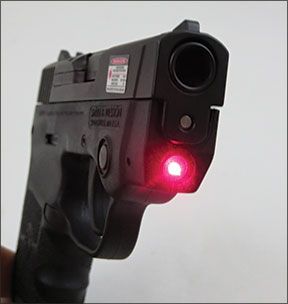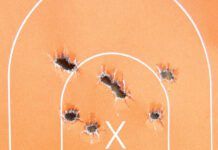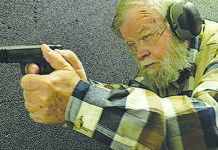The S&W Bodyguard is a DAO (Double Action Only) semi-auto pistol that is familiar to our readers and testers. As we did with the Ruger LCP-LM, SIG Sauer P238 Tactical Laser, and Walther PK380 with Laser in the February 2013 issue, we tested the Bodyguard for accuracy at 15 yards with open sights but were more focused on using the laser. We tested each concealable pistols ability to quickly activate its supplied laser and allow the shooter fire the pistol using only the laser as the aiming device. Similar to the last test, we used the same ammo and D-1 tombstone-style targets. We also need to note again that there is a reason for the laser warning label on the Bodyguard. It employs a red Class IIIa laser that should not be pointed in eyes, as permanent eye damage can result. Also laser beams reflect off surfaces like TV/computer screens, mirrors, glass, etc. Make sure you test the laser of an unloaded weapon to experience how the laser reacts on certain surfaces.

S&W Bodyguard 380 No. 109380 380 ACP, $419
There was no doubt in any of the testers minds that the Bodyguard had the most integrated laser. The InSight laser is built into the dust cover of the polymer frame of the pistol. Nothing bolted, nothing looking like an afterthought. The Bodyguard was designed from the beginning with the laser sight in mind. Unlike the Walther and SIG, but similar to the Ruger, the S&W could definitely be carried in a pocket without notice. The Walther and SIG required a holster, in our testers opinions. The sights on the Bodyguard were a nice compromise between the SIGs nearly full-size sights and the sights subtly milled into the top of the Rugers slide. Both of the Bodyguards sights were adjustable for windage via a punch and hammer. They were also snag free, which is what we like in a pocket pistol.
The left side of the pistol held the takedown lever, slide stop and a thumb safety embedded in the polymer frame so they were snag free and smooth. Testers liked the additional security of the thumb safety, others thought the sheer simplicity of the mechanism – devoid of thumb safety yet drop safe – was a plus.
The laser activation button was soft, circular rubber item with a slight ridge around it to prevent it from being turned on accidentally. Like the other pistols, the laser could be activated when pressed through the canvas fabric of a pant pocket. The activation button naturally fell under the trigger finger tip. It was easy to turn on and, after a series of presses, turn off. Press the button once and the laser is in steady beam mode. Press it twice to get to pulsating mode, and press it a third time to turn it off. An activation button was located on both sides of the pistol, so it was ambidextrous. The laser sight is adjustable for windage and elevation with a supplied hex wrench thats so skinny you can pick your teeth with it. Adjustments were easy to make: Line up the sights at the zero distance and walk the red dot so it sits atop the front sight. We zeroed it for 15 yards.
At the range, the same ammo brands and in most cases lots were used: Hornadys XTP and Z-Max JHP and PPUs FMJ loads. From the outset, the Bodyguard had trouble firing the PPU cartridges, but the DAO trigger allowed the user to keep pulling the trigger to fire the round. It should be noted that none of the other previously tested 380s had any trouble firing the PPU rounds. We expected similar performance from the Hornady cartridges, but the Bodyguard consumed them without a hitch. As with all the laser-equipped 380s tested, bright sunlight hides the projected dot, so remember to practice with irons sights and not rely solely on the laser dot. When the sun goes down is when the laser sight showed its value. The pistol could be fired accurately from a standing position at hip level as it just cleared a pant pocket.
Our Team Said: They liked the fact the slide locked back after the last round was fired. The issue with the PPU ammo was noted, but most testers would not use FMJ ammo in the tiny S&W anyway, so we reduced the guns grade only half notch. Though the Ruger was less expensive, some testers would opt for the more costly Smith & Wesson Bodyguard.
Written and photographed by Robert Sadowski, using evaluations from Gun Tests team testers. GT





















I was unable to see ACCURACY pdf and SW BODYGUARD pdf